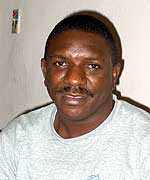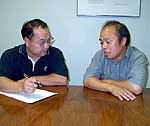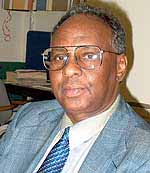By Andrew Haeg
Minnesota Public Radio
August 27, 2002
Low interest rates continue to fuel demand for homes, despite a weak economy. Last month, for instance, national sales of new single-family houses rose to a record level. Experts say immigration is helping to fuel demand for homes nationally and in Minnesota. Real estate experts say immigrants are an increasingly important part of the real estate market, and lenders are taking steps to accomodate them.
| |
|
|
|
||
Five years ago Michael Udo was living in Lagos, Nigeria. But political and economic turmoil made life uncertain, and his prospects dim. So he and his wife moved to the United States - first to New Jersey, then to Minnesota. Upon his arrival, Udo set out to learn what opportunities existed, and what he should do next.
"We decided to study the society and know which way might be OK for us, because moving and starting life all over again is not that simple," Udo says. "So you have to find the area of, 'What should I do first so that my family will be comfortable, and I can be financially OK.' So we look at all areas and real estate was the only option."
Two years ago, Udo bought a duplex on the east side of St. Paul for $125,000. It was his first step on a path he hopes will lead to a career in real estate. He rented out the other half of the duplex, and used the rent to virtually eliminate his mortgage payments. He and his wife fixed it up - nothing major, just a fresh coat of paint.
Now, like so many homeowners recently, Udo's personal wealth has expanded substantially along with the price of his home. He just sold his duplex, for $188,000. That's a 50 percent gain in just two years.
| |
|
|
|
||
"It means a lot," Udo says. "It puts us in a place where we don't have to live from paycheck to paycheck."
With the proceeds, Udo's now bought another duplex nearby for $55,000. It's cheap, but he's putting a lot of work into it. He's torn down a wall and mended cracks in the plaster.
Udo and his family will move into one half of the duplex and rent the other. Udo says he doesn't plan to sell this house anytime soon. It's a vital piece of his financial plan.
"Hopefully, this should pay for my son's college tuition," Udo says.
IMMIGRANTS A GROWING SECTOR OF THE REAL ESTATE MARKET
Home ownership among immigrant groups nationwide still lags far behind that of the native born population, but immigrants are catching up. According to the U.S. census, five percent of Minnesotans are foreign-born - that's double the percentage in 1990. And more immigrants in Minnesota are buying homes. Hmong homeownership, for example, has risen from 14 percent to 50 percent since 1990, according to the census.
| |
|
|
|
||
Nationwide, home ownership among Southeast Asian and Hispanic immigrants has risen several percentage points in the past decade, according to the Joint Center for Housing Studies at Harvard University.
George Karvel, professor of real estate at the University of St. Thomas, says demand for homes from immigrants is one of the forces keeping the local real estate market strong.
"There is a continuing demand - as new people move into the area, as young people come of age to buy homes, and as immigrants move into the Twin Cities," Karvel says.
Research indicates that, over time, immigrants eventually buy homes at a rate approaching that of the native population.
"If you look at the immigrants who arrived ... between 1975 amd 1979 - in 1980, their home ownership rate was just 19.5 percent," says Jim Freund, a spokesman for the Mortgage Bankers Association. "Two decades later, by 2000, it was up to 57 percent. That compares to 67 percent for the native born. So the gap closed radically over that period."
LENDERS ADAPT TO IMMIGRANTS
Mortgage lenders say they'd like to see that gap close even further. Amy Grayson is the Minnesota regional emerging markets director for Wells Fargo Home Mortgage in Minnesota. She says the bank has realized that newly-arrived immigrants present a big opportunity.
| |
|
|
|
||
"The whole focus of our emerging markets division is to make sure we are developing products and services to help us continue to tap into the opportunity that these communities are representing," says Grayson.
Wells Fargo and other mortgage lenders are accommodating newly-arrived immigrants through a series of measures. Many lenders, for example, now recognize cash on hand as evidence of savings for people who don't have bank accounts. They have also expanded the definition of credit history to include utility bills, and other evidence that candidates can pay their mortgages.
Kit Hadley, commissioner of the Minnesota Housing Finance Agency, says lenders can't treat newly-arrived immigrants like the rest of the population.
"We can't ask, 'How did you do on your mortgage payments on your former home?' There weren't any. So if that's all we're looking at - how people performed when they were in debt, how did they do on their consumer debt - for a group of people who had no consumer debt," says Hadley, "we're essentially shutting the door to homeownership completely. All kinds of institutions have had to think differently."
|
"We can't ask, 'How did you do on your mortgage payments on your former home?' There weren't any. ... All kinds of institutions have had to think differently."
- Kit Hadley, Minnesota Housing Finance Agency, on working with immigrant homebuyers |
Hadley and others say education may be just as important as providing new products and services. To that end, lenders and community groups across the state are running home buyer education in Spanish, Khmer for Cambodians and Hmong.
Pao Yang of Community Neighborhood Housing Services in St. Paul helps fellow Hmong immigrant Yee Lor learn what it will take for him to buy a home. Lor moved here from Laos in 1989. He owned a home in St. Paul before, but had to rent again after losing it to a fire. With Yang serving as translator, Lor says his $800 a month in rent only buys him a two-bedroom apartment for his family of seven.
"He figured that since he's paying $800 for a two-bedroom, he'd rather own a home," says Yang.
Other groups are finding new ways to help immigrants own homes. Habitat for Humanity, for example, offers interest-free financing on the homes it builds. That's especially helpful for Muslims like Osman Ahmed, for whom paying interest would violate his religious beliefs.
Ahmed bought a Habitat for Humanity house after he fled the civil war in Somalia. He says owning a home means he no longer has to worry about being thrown out on the street.
"When you have ownership, you feel very happy. You don't think that tomorrow the owner of the home will come here and they say the contract is finished. I am happy completely. I am a very very lucky person," says Ahmed, who celebrates his third year as a homeowner in February.
More from MPRMore Information




